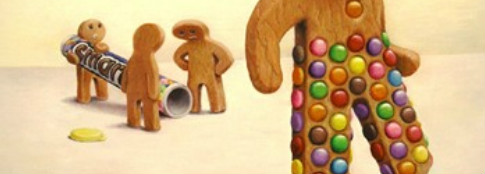Entry 2 Math is Written all Over the... Grocery Store!
Observation: I went out for a walk today, and thought I`d pass by the local grocery store for some fresh vegetables for tonight`s dinner. While trying to find all of the groceries I had in mind, I came across a little boy who was shopping with his mother. By observing him, I learned that kids enjoy grouping things, numbers and groceries alike. After listening to the conversation he was having with his mother, I couldn`t help but notice how similar everything became in the store. He pointed at certain groceries and signs and shook his head at certain things his mother touched. Who knew a trip to the grocery store could be a math lesson all on its own? For a few minutes I felt like I was back in grade 4 and a kid again! Green peppers and red peppers, eggs, cookies, even signs seemed to be interconnected. Eggs reminded me of the number 12, the red and green peppers were 84 cents a pound (7x12) and the sign said 6 items or less(12 divided by 2). The child was thinking of like numbers; how the number twelve could be divided and multiplied and so forth. It was his way of learning and understanding numbers in relation to the world around him.
Reflection: Students are very good at making connections between things. Most times, making connections is the only way a student can remember and understand certain things. A great lesson plan on multiplication could be on the identification of the number 12 as a number that can be used in a variety of settings, and therefore used quite frequently. We all remember those multiplication tables, teachers asked us to write out, cut out and paste in our binders. We were encouraged to memorize the table by a certain date, a dreadful thing nobody looked forward to. I remember that only three quarters of the class memorized the table, and for the part that did memorize the table they could barely reach the 12 time tables. We were in higher grades, and were expected to know the table...dice, play money, and blocks were for “small children” and weren`t used.
The other day at one of the orientation lectures, a teacher suggested that learning strategies and lesson plans at the junior intermediate level are surpringly looking more and more like those from a primary junior level. Just as the boy in grocery store grouped groceries into categories that related to numbers that equalled the same number when divided and multiplied, students should be able to do the same thing within the classroom. If it means that the student can get a better grasp of the symbol, why not use blocks and pictures. Another way to engage students into learning and understanding numbers is by relating the subject of math to subjects that they really excel at (considering that math isn`t their strongest subject. For instance, students who`s subject they excel most in is History, a visual timeline, with pictures along with small characters that move along the timeline to show the addition or subtraction of years. By connecting two subject areas, students can take what they know and enjoy from the subject they excel at most, and use the information and knowledge they have of it towards understanding another subject such as math.
